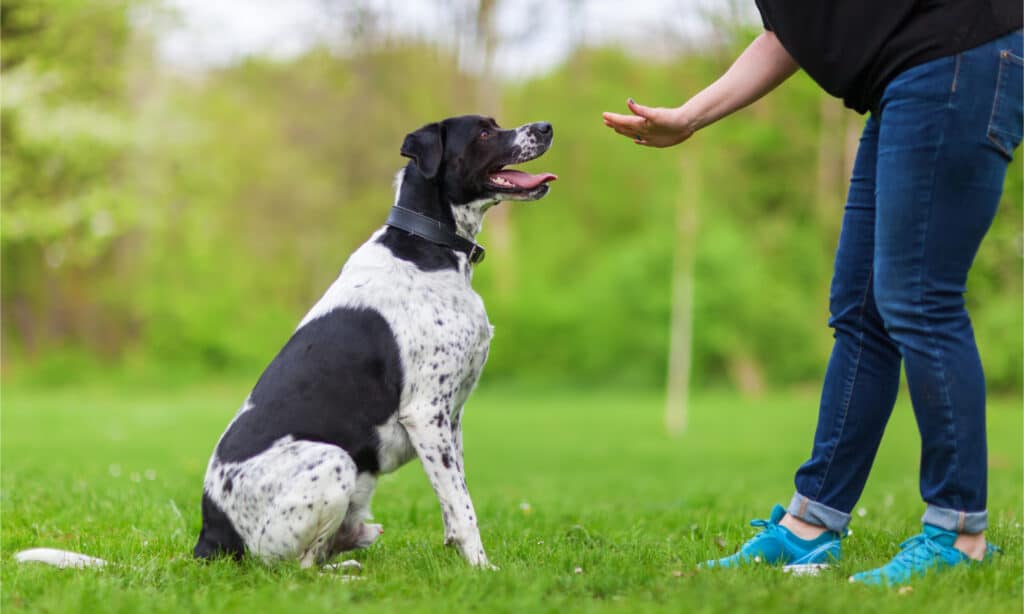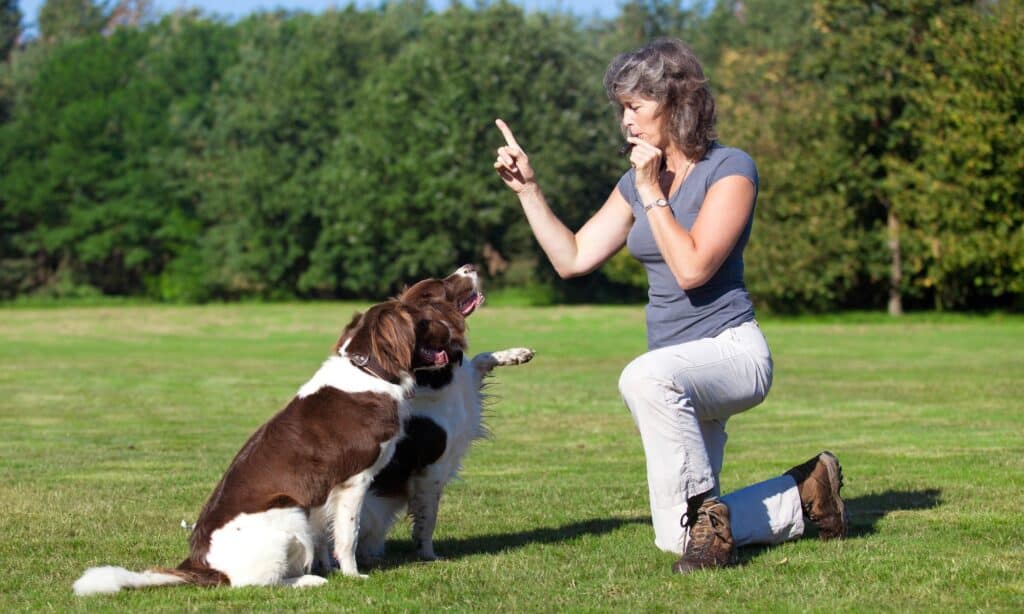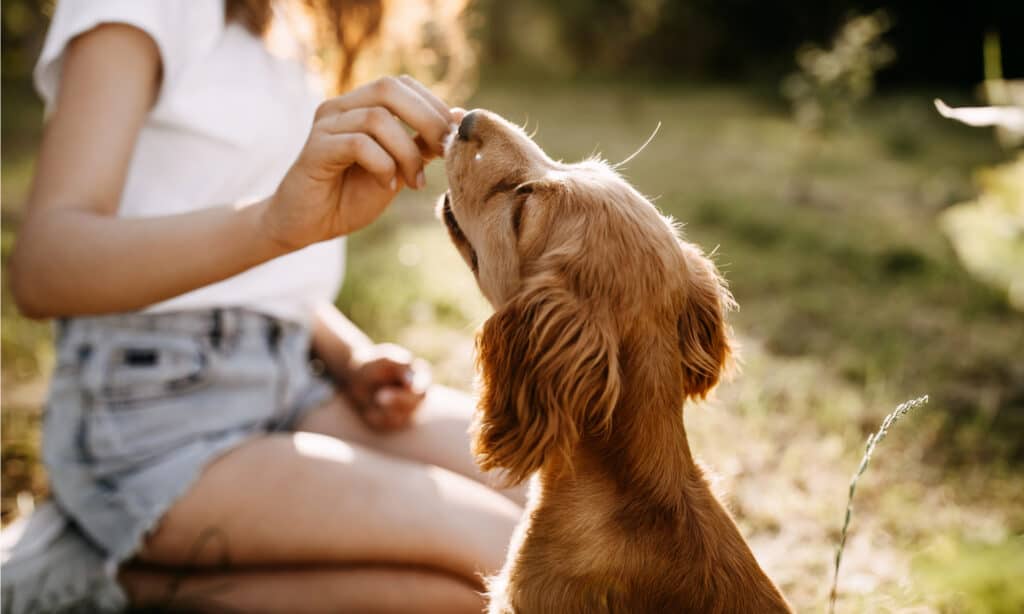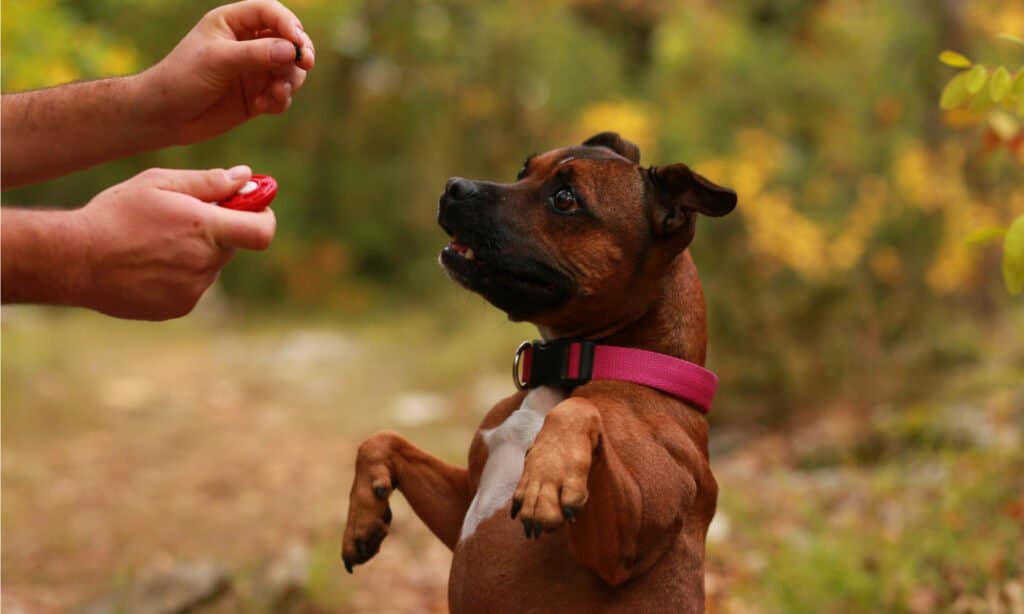With so much dog training advice out there, it can be difficult to find an effective obedience training method. Whether you’re adopting your first dog or already struggling with misbehaviors, this article will help.
The most effective and humane methods of obedience training are those that fall into the “force-free” category. These include positive reinforcement, mirroring, and management. When your dog misbehaves, it’s best to redirect its behavior. You can also stop giving them attention, so they learn what you will and won’t accept from them.
In this article, we’ll talk about all of these methods and more–including training methods to avoid.
What to Look for in a Training Method

The dog training industry is completely unregulated. This allows for a lot of misinformation, faulty training methods, and even outright abuse to take place.
©Christian Mueller/Shutterstock.com
When researching obedience training or trying to find the right trainer for your dog, always choose methods that aren’t harmful.
Unfortunately, the dog training industry is completely unregulated. This allows for a lot of misinformation, faulty training methods, and even outright abuse to take place.
A good training method should:
- Never hurt a dog
- Show respect to your dog as a living being
- Take into account the newest science regarding dog learning and behavior
This is why I’ll only be referring to force-free training methods in this article (also sometimes known as relationship-based training). This is the only method that commits to treating a dog with respect. This method won’t harm your dog physically or emotionally.
Four Quadrants of Dog Training
There are four quadrants when it comes to dog training: positive reinforcement, positive punishment, negative reinforcement, and negative punishment.
Positive reinforcement is using rewards to motivate your dog. Conversely, negative punishment is taking away something they enjoy to discipline them.
When playing fetch, you use positive reinforcement. Your dog brings back the ball, and their reward is to have it thrown again.
A common way to use negative punishment is when a puppy bites during play. Instead of reacting, simply get up and walk away. With repetition, your puppy learns that playtime is over when they bite. This leads them to stop biting because they want playtime to continue.
These are great methods to use while training. Refrain from using positive punishment, which includes shocking or yelling, to discourage a dog’s behavior. In addition, never use negative reinforcement, which is doing something your dog dislikes to force them to behave.
Obedience Training for Dogs: Positive Reinforcement

A common way to use negative punishment is when a puppy bites during play. Instead of reacting, simply get up and walk away.
©Christian Mueller/Shutterstock.com
Positive reinforcement means giving your dog a reward for good behavior. Most simply, this means teaching them a trick and giving them a treat when they listen to your command.
However, positive reinforcement can be used in many more ways than this. Other examples of positive reinforcement include:
- Keeping a toy on hand to distract your dog from others on a walk.
- Playing tug-of-war to reward them for not lunging toward other people or dogs.
- Praising your dog using an excited voice after they complete a task.
- Tossing a ball after your dog comes when called.
Some dogs aren’t food-motivated and might need other motivators like play or praise in order to learn new things effectively.
Obedience Training for Dogs: Redirection
Redirection takes your dog’s focus off of its misbehavior and directs it toward a more acceptable target.
This might mean giving your teething puppy a chew toy, so they stop gnawing on your fingers. You can also lure your reactive dog off of a path with treats when another is about to pass by.
It could even mean calling your puppy outside when you see they’re about to pee in the house.
Redirection works best when you can predict your dog’s behavior and guide them to another activity before misbehavior occurs.
Regardless, though, redirection can also work in some situations when your pup is already misbehaving.
Obedience Training for Dogs: Negative Punishment (Ignoring Bad Behavior)
Negative punishment sounds bad. But as you can see in the section above, it’s actually a good training method when used correctly.
Negative punishment means taking away something your dog likes in order to get them to behave. This is most commonly your attention.
For instance, ignoring a dog when they bite, hump, or do something else you dislike can teach them that you won’t tolerate that behavior. Many people’s first instinct is to scold their dog in these situations, but that’s actually less useful and can even backfire. Some pups think yelling is funny or that you’re encouraging them to keep on, especially if they’re already wound up.
Of course, we can’t ignore these behaviors completely and just let them continue. A good solution is to remove either ourselves or the dog from the situation. This can include walking away or putting them in a safe room or crate.
While crates should never be used as punishment, being neutral while you put your puppy in the crate (no scolding!) and giving them a few minutes to calm down can do wonders for overly rambunctious pups.
Obedience Training for Dogs: Mirroring

Many people’s first instinct is to scold their dog, but that’s actually less useful and can even backfire.
©iStock.com/Peter-verreussel
Mirroring, or model-rival training, is when someone else (usually another dog) models good behavior for your dog.
Dogs learn by observing other dogs all of the time, and if you have multiple dogs, you might even see this happen naturally.
A silly example of mine is that my late dog Charlie learned to eat foods he always refused, like vegetables, once he saw his best friend eating them during her visits!
Some more practical uses of mirroring might be going on walks with well-behaved dogs so that your dog learns how to walk on a leash or having your older dog perform a trick in front of your puppy and giving them lots of praise. Your puppy will see that, want your attention too, and might try to replicate what they saw!
Obedience Training for Dogs: Management
Management in dog training means managing the situation to prevent misbehavior from happening. The key is to know what your dog can handle and keep them below their threshold for becoming distracted, overstimulated, or anxious.
For instance, most people teach their dogs to sit or walk on a leash inside of their homes. Once the dog has perfected the trick in a quiet space with few distractions, you might go out into the backyard, train with the rest of the family around, etc.
Slowly upping the distraction level like this sets your dog up for success and doesn’t put them in a place where they simply can’t listen!
Other forms of management include:
- Puppy-proofing your home so the new puppy doesn’t get into things they shouldn’t
- Putting away food before leaving a room, rather than leaving the dog unattended and expecting them not to eat it
- Using baby gates to block access to the front door if your dog likes to dash past people going in or out
- Separating two pets who cannot get along to prevent fighting
Sometimes, it’s easier to manage the situation than it is to train your dog to change its behavior. Other times, management is needed until your dog’s behavior has changed, and you can rely on them to behave on their own.
Obedience Training for Dogs: Desensitization and Counterconditioning

Desensitization means exposing your dog to the thing they dislike or fear slowly so that they don’t become panicked or overwhelmed.
©Natalia Bostan/Shutterstock.com
This training method is typically used on dogs who are fearful but can also be used to prevent fear from developing. It involves reintroducing them to their fear slowly and positively so that they learn to be confident and fearless.
Desensitization means exposing your dog to the thing they dislike or fear slowly so that they don’t become panicked or overwhelmed.
Counterconditioning is conditioning your dog to associate the scary thing with a good thing, like treats!
An example of this is slowly introducing nail trims by first desensitizing your dog to having their paws touched, then getting them used to the clippers, and finally cutting one to two nails at a time.
For an already fearful dog, let’s look at what we’d do if a dog feared the comb because they were used to being matted and having their fur pulled.
Once their coat was back in shape, you would slowly reintroduce the brush by giving them treats for sniffing it or touching their nose to it. Then, you might touch them with the brush gently and give them a treat each time.
Eventually, you’d work up to a single stroke of the brush, then more as the dog accepted that combing didn’t actually hurt–and meant there were plenty of yummy treats coming their way!
Training Methods to Avoid
Dominance Theory of Dog Training
Dominance or “Alpha Dog” training used to be very popular, but luckily is decreasing in popularity with more modern and humane methods taking their place.
The basis of this method is that you must be the alpha dog, leading the pack, in order to get your dog’s respect. Trainers often recommend using force to get your dog to behave.
This is based on a faulty study of wolf packs, which found that wolves have a hierarchy established by force and violence. In actuality, this study was done on captive wolves who were poorly kept and thus competing for resources in order to survive.
In the wild, wolves live in family structures much like our own. The mother and father are typically in charge, but they don’t rule by force, and there aren’t other wolves coming in to kill the “alpha dog” and take their place!
It’s since been shown that this method is not only founded on misinformation about wolves but that it’s harmful to dogs and our relationships with them. Dominance training can cause fearfulness and aggression.
Balanced Training

Avoid aversive methods as often as possible.
©Melounix/Shutterstock.com
Balanced trainers claim to be the healthy middle ground between aversive methods and force-free training. However, many of them lean further toward aversive methods than they do humane ones.
While there is a wide spectrum when it comes to balanced training, all balanced trainers are willing to use aversives. Personally, I find it unethical to hurt a dog or cause them discomfort in order to get them to comply.
This is why I recommend avoiding balanced training, and balanced trainers, completely.
Shock Collars
In recent years, I’ve noticed aversive dog trainers rebranding shock collars as “e-collars” to make them seem nicer. This is certainly because of growing public awareness of how unethical shock collars are.
These collars might shock, vibrate, make noise, or spray citronella (which is toxic to dogs) as a punishment. Many will provide several of these features.
Some people claim that “only” using sound or vibration settings is okay. But the reason this stops a dog’s behavior is that they find it so upsetting.
Others might use the shock feature at the start, then rely on the fear and trauma their dog faced to get them to behave in the future. In this case, the sound or vibrating features are like threatening the dog that it’ll be hurt again if they don’t listen.
There are more humane methods that don’t require making your dog uncomfortable in order to get your way during training. We suggest avoiding this method.
Other Aversives

Dogs learn by observing other dogs all of the time, and if you have multiple dogs, you might even see this happen naturally.
©Paya Mona/Shutterstock.com
Other aversive methods include choke collars, prong collars, and “gentle leaders” that go on your dog’s snout. Some aversive trainers might not use the labels above but are still willing to harm a dog for compliance.
I recommend avoiding all of these as well as the list above.
It’s admittedly difficult, and maybe impossible, to avoid all aversives entirely. After all, who hasn’t scolded their dog, even knowing it’s ineffective?
But, ideally, we avoid aversive methods as often as possible. This is how we build trust with our dogs and treat them like the wonderful living, breathing animals that they are!
The photo featured at the top of this post is © Paya Mona/Shutterstock.com
Ready to discover the top 10 cutest dog breeds in the entire world?
How about the fastest dogs, the largest dogs and those that are -- quite frankly -- just the kindest dogs on the planet? Each day, AZ Animals sends out lists just like this to our thousands of email subscribers. And the best part? It's FREE. Join today by entering your email below.
Thank you for reading! Have some feedback for us? Contact the AZ Animals editorial team.







